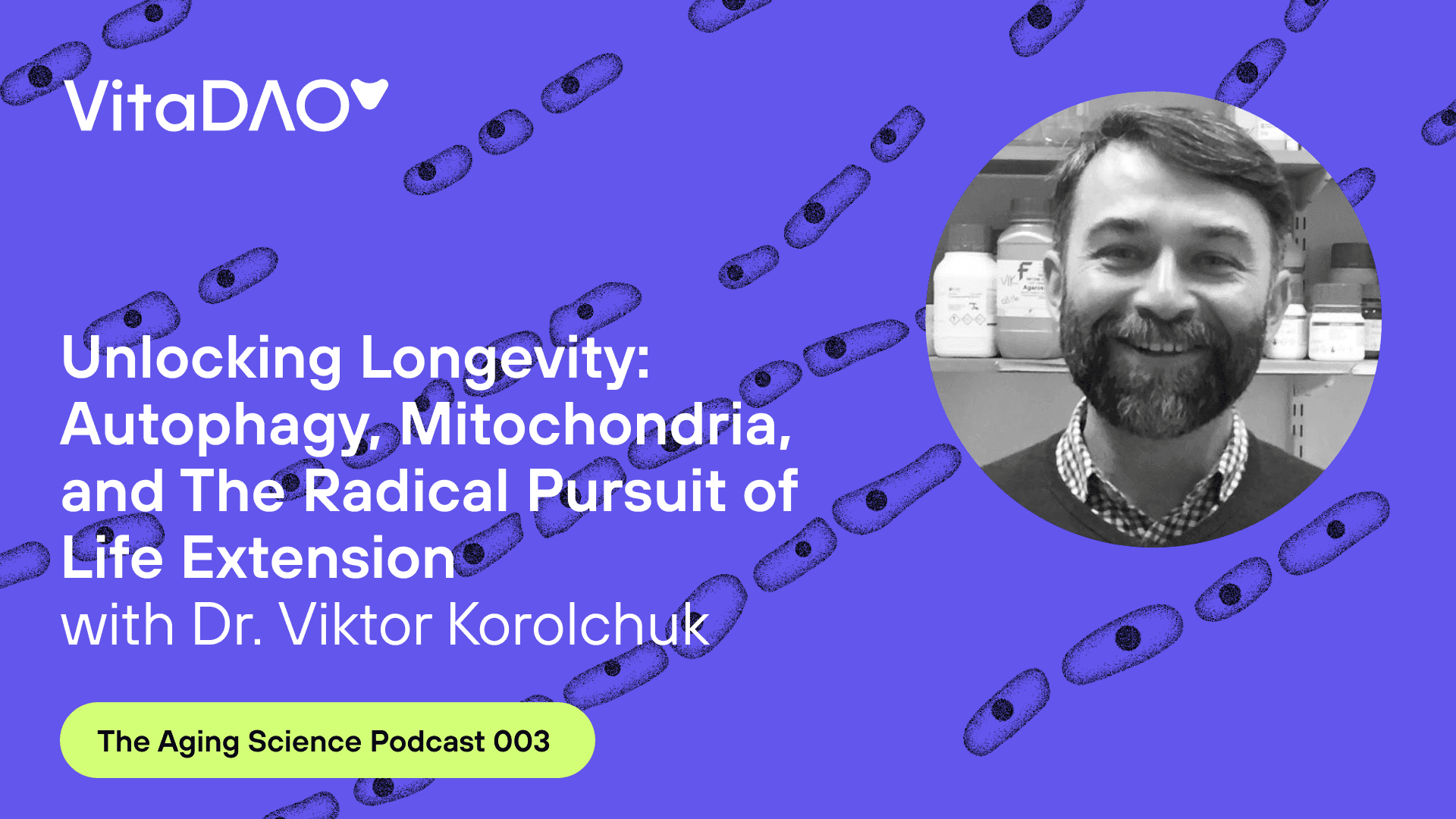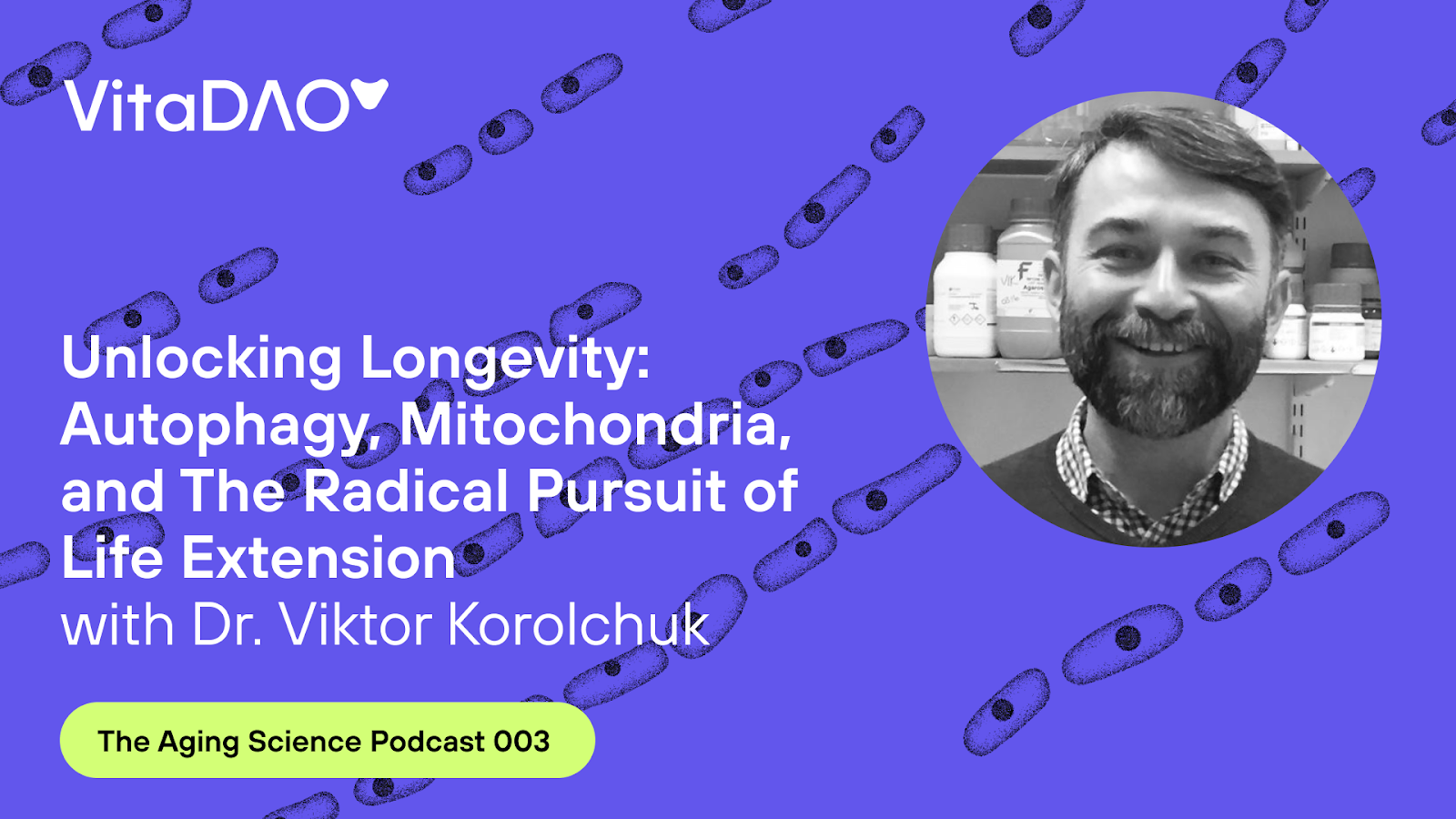
Unlocking Longevity: Autophagy, Mitochondria, and The Radical Pursuit of Life Extension during The Aging Science podcast by VitaDAO


Check out the podcast here.
I (@aging_scientist) had a marvelous conversation with Assoc. Prof. Viktor Korolchuk (@VIKorolchuk) about autophagy, mitochondria, senescence, the importance of modelling and human desire for radical lifespan extension. Originally from Ukraine where he received his PhD, Viktor worked in Cambridge as a postdoctoral fellow and later moved to Newcastle upon Tyne in the beautiful north of the UK to pursue his work on aging.
He has received a grant from VitaDAO to identify novel autophagy activators against aging and lysosomal storage disorders.
https://www.vitadao.com/projects/korolchuk-lab
Lab page: https://www.ncl.ac.uk/medical-sciences/people/profile/viktorkorolchuk.html
Below we will review some of the concepts we discussed in the podcast.
Mitochondria – multifaceted players in aging
These organelles are often called the powerhouse of the cell but, apart from being cliched, this metaphor does not do them justice. If we stick to that “urban” metaphor, the mitochondria are maybe like a manufacturing plant, a port, a power plant and a minor geopolitical center all in one. Given the complex responsibilities of mitochondria it should not come as a surprise that they have diverse failure modes during aging.
For example, during aging we see clonal expansion of point mutations and deletions which leads to tissue mosaicism, meaning that one and the same tissue ends up having stretches of totally different, often more or less dysfunctional, mitochondrial populations.
There is also the classic mitochondrial (mt) free radical theory of aging. In one more modern interpretation of this theory, production of radical oxygen species (ROS) at mitochondria is a constant source of macromolecular damage irrespectively of whether this mtROS production increases with aging or not. This is consistent with and supported by findings of reduced mtROS production (Lambert et al. 2007) and higher membrane lipid stability in long-lived species.
In some aging tissues we observe reduced mitochondrial mass and decreased mitochondrial biogenesis (1). Based on this we would expect increased mitochondrial biogenesis to improve healthspan or lifespan, and, indeed, PGC1a is consistently upregulated in long-lived rodents and overexpression of this gene extends fly lifespan (Tyshkovskiy et al. 2019, Ozkurede et al. 2019, Rera et al. 2011).
Although we do observe decreased mitochondrial mass in some tissues, in other tissues there may be a vicious cycle of defective mitochondria that proliferate out of hand. The latter is a theory which is bolstered by the work of Aiken and McKenzie (Herbst et al. 2022) as well as work by Prof Doug Turnbull from Newcastle (Vincent et al. 2018).
Some other theories suggest that aging mitochondria lead to increased susceptibility to cell death, and that the mitochondrial network becomes disorganized with impaired fusion-fission dynamics.
And this is just a small sample of mitochondrial aging theories!
Rapamycin, mTOR and its effects on aging
Rapamycin is an approved immunosuppressant drug that is produced by a type of bacteria from the Streptomyces genus. The drug was first isolated from a soil sample found at the island of Rapa Nui hence the name.
Most of its effects are mediated via inhibition of the mTOR pathway. Generally speaking, this pathway is turned on during cellular growth when nutrients are abundant and need to be utilized for growth, and it is turned off during starvation when the cell needs to focus on survival, efficiency and recycling.
This relatively obscure drug has become the superstar and a major workhorse in biogerontology because it extends mouse lifespan and also leads to many physiologic changes that appear beneficial.
These include increased autophagy, reduction of the senescence associated secretory phenotype (SASP), reduced cell growth and protein synthesis etc. Interestingly, rapamycin is not primarily senolytic, i.e. it does not kill senescent cells, rather it reprograms them to be less harmful. It remains a matter of debate which downstream effects of rapamycin are responsible for the lifespan benefits. Nonetheless, the efficacy of rapamycin does provide some evidence for the importance of autophagy during aging.
Senescence
Senescence is an irreversible non-proliferative state. This means senescent cells exit the cell cycle and stop growing, instead they secrete cytokines and growth factors, many of which are harmful. Senescence is considered anti-tumorigenic and senescent cells are involved in wound healing and possibly other physiologic processes like insulin secretion or structural integrity of tissues. Perhaps some of these secreted growth factors serve a purpose and therefore the removal of senescent cells poses a health risk.
However, given that ablation of senescent cells improves healthspan and extends lifespan in mice this suggests that, on balance, these cells are harmful. This alone does not explain the hype around senescence and senolytics (therapies that remove senescent cells).
The topic of senescence has received a lot of attention in the field, specifically because a single ablation treatment in mid-life can have lasting health benefits in mice. This is basically a dream therapy come true if it translates to humans. One time treatments are cheap and safer than chronic treatments, making them perfect for clinical use.
Senescence can be triggered by DNA damage, oxidative stress, telomere erosion, viral infection and many other stressors. This links senescence as a kind of downstream “damage” with many modern aging theories, like the stress resistance theory of aging, for example.
Autophagy and aging
"some of the data with these [autophagy-inducing] molecules looks almost magical" (Viktor Korolchuk)
The word autophagy describes a process of self-eating and self-recycling that almost every cell in the body utilizes. This process is necessary for a cell in order to adapt to changing environmental conditions. Organelles and proteins that are not needed in a given situation are broken down into their components, amino acids or lipids, for example, which are used to assemble whatever the cell needs at that moment. Another key function of autophagy is quality control and maintenance through the removal of damaged and dysfunctional organelles or proteins.
Especially during starvation autophagy is needed to fuel essential cellular processes and to use cellular proteins for the production of energy (ATP).
We can distinguish several types of autophagy based on their molecular characteristics. The three key types are macroautophagy, microautophagy and chaperone mediated autophagy (CMA). As the name suggests macroautophagy degrades large, bulky structures whereas the other two do not. Chaperone mediate autophagy uses so called chaperones to help unfold proteins and import them into the lysosome, where they will be degraded. There is also crosstalk between the different types which makes it hard to study them individually due to compensatory mechanisms.
Macroautophagy has attracted a lot of attention because it is easy to measure and may remove damaged organelles and proteins believed to accumulate with aging. Macroautophagy itself is also subdivided into bulk and selective autophagy, the latter includes the autophagic degradation of organelles like mitochondria (mitophagy), peroxisomes (pexophagy), etc.
We have a lot of evidence which suggests that increased autophagy can delay aging. For example, there are comparative studies showing that cells from genetically longer-lived mice show more prolific autophagy. There is also a hint of increased autophagy in long-lived species more broadly.
The most specific and direct evidence comes from invertebrates, however, where it is possible to show that autophagy genes are necessary for the effects of caloric restriction. These things are always harder to show in mammals. However, we do have several genetic gain-of-function studies in mice suggesting that increased autophagy does indeed extend lifespan (e.g. Fernández et al. 2018), although they have their own limitations.
Other than that, there is a lot of indirect evidence. We know that many lifespan extending strategies in mice have autophagy in common, e.g. rapamycin and caloric restriction both induce autophagy.
Interestingly, autophagy deficient mice die early during life, whereas autophagy deficient cells appear fine at first glance. However, Viktor mentions that they have problems when they are forced to respire and utilize their mitochondria, which is when they start dying. This is why, in his VitaDAO project, he can use a viability assay in autophagy deficient cells to find novel autophagy inducers.
The philosophy of lifespan extension
Towards the end of the podcast, we had an interesting foray into the important question of “how long would you want to live?” and both Viktor and I agreed that: "an average person...would choose to live indefinitely if they were in good health, mental and physical".
However, this question is very sensitive to the phrasing and there are certainly people who would like to choose differently. If you are interested in understanding the psychology and philosophy behind this question, I have written extensively on this topic before and one of my recent blog posts might be a good primer for this kind of debate.
How long do you want to live? (June 22, 2022)
http://biogerontolgy.blogspot.com/2022/06/how-long-do-you-want-to-live.html
Important Reading (selected references)
Herbst, Allen, et al. "Age-and time-dependent mitochondrial genotoxic and myopathic effects of beta-guanidinopropionic acid, a creatine analog, on rodent skeletal muscles." Geroscience (2022): 1-13.
Ozkurede, Ulas, and Richard A. Miller. "Improved mitochondrial stress response in long‐lived Snell dwarf mice." Aging Cell 18.6 (2019): e13030.
Tyshkovskiy, Alexander, et al. "Identification and application of gene expression signatures associated with lifespan extension." Cell metabolism 30.3 (2019): 573-593. webpage: http://gladyshevlab.org:3838/Gentervention/
Rera, Michael, et al. "Modulation of longevity and tissue homeostasis by the Drosophila PGC-1 homolog." Cell metabolism 14.5 (2011): 623-634.
Gonzalez-Freire, Marta, et al. "Reconsidering the role of mitochondria in aging." Journals of Gerontology Series A: Biomedical Sciences and Medical Sciences 70.11 (2015): 1334-1342.
Lambert, Adrian J., et al. "Low rates of hydrogen peroxide production by isolated heart mitochondria associate with long maximum lifespan in vertebrate homeotherms." Aging cell 6.5 (2007): 607-618.
Fernández, Álvaro F., et al. "Disruption of the beclin 1–BCL2 autophagy regulatory complex promotes longevity in mice." Nature 558.7708 (2018): 136-140.
Vincent, Amy E., et al. "Subcellular origin of mitochondrial DNA deletions in human skeletal muscle." Annals of neurology 84.2 (2018): 289-301.
(1) Regarding reduced mitochondrial biogenesis and mitochondrial mass during aging: I remain somewhat unconvinced by this aging theory, although I have not looked at this in much detail. If decreased biogenesis was a main driver of aging it should occur in both sedentary and exercised individuals, since both of them do show muscle aging, but this is not the case:
“However, it has become increasingly clear that most of the declines in mitochondrial biogenesis, turnover, and function are a consequence of physical inactivity. Indeed, when physical activity levels are matched between young and elderly people, or physical activity is otherwise taken into account, most investigations do not find any age-related changes in mitochondrial enzyme activities, mitochondrial respiration, or ATP flux” (Barbieri et al. 2017)
On the other hand, given this evidence, it appears that aging increases the susceptibility to muscle loss, including reductions in mitochondrial mass and biogenesis. This by itself does appear to be a proper aging phenotype -- consistent with the concept of reduced resilience during aging.


